WHAT'S NEW:
BACKGROUND:
Mission
Project Description
Cruise Plans:
Participants
Technology (ROV, ships, etc.)
Future Plans
Results:
1998 NeMO Cruise
Axial 1998 "Eruption"
Science News
Science Reports-
R/V Thompson Science Report:
July 13, 1999
Perspectives at the End of NeMO99
Bob Embley-NeMO99 Chief Scientist
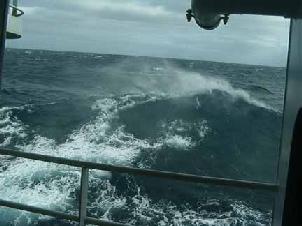 Heavy seas on the last days of the cruise prohibited any further dives and made the ride home a rock n' roll experience. |
Overall, this year's cruise rivaled the success of NeMO98 and the scientific party will again have a full load of samples and data to analyze. The effects of the 1998 eruption are still apparent on the eastern side of the caldera where the lava flow was erupted. Venting continues in many places (e.g. Marker 33, Cloud, and Magnesia), whereas there has been reduction or cessation in others. Although the amount of visually apparent microbial activity (such as the white floc in the water column) has decreased, there continues to be concentrated"snowblower" activity at some vents (e.g. Magnesia Vent) and hyperthermophilic microbes were again found in abundance at most of the diffuse (low temperature) sites, (whose temperature is well below their optimal growth rate). These observations lead to the conclusion that there is still enhanced subsurface microbial growth more than a year and a half after the eruption.
We found the likely southern end of the lava flow about 6 kilometers south of the caldera lava along a spectacular fissure system that was followed for hundreds of meters. In some places the eruption was entirely contained in the 1 to 2 meter wide fissure. Eventually, it overflowed its fissure and erupted in the large mound of lava that we first saw last year. Farther north towards the caldera, the trace of the 1998 lava became more confused as the slightly older eruptions mixed with the 1998 lava. Active hydrothermal venting was only found on the summit of Axial, probably where the underlying zone of molten lava permanently resides. The summit area contains hydrothermal systems formed during several different volcanic or tectonic (earthquake generated) events, providing a natural laboratory for studying colonization and evolution of these unique chemosynthetic ecosystems.
One of the viewers from our WWW audience asked the question:
"What are we doing out here that will make a difference in people's
daily lives?"
This is a good question, and I'd like to try and answer it on
several levels. First of all, I believe that ocean floor research is one
of the last frontiers of terrestrial exploration. We literally know more
about what the surface of the moon or even Mars looks like than we do the
floor of Earth's oceans. Hidden below the ocean's is the earth's largest
volcanic system, the
60,000 km long Mid-Ocean Ridge. The ridge grows by
the process of
seafloor spreading, by which the earth is actually renewing
its surface. Surprisingly, little is known about the actual processes
that form this feature, because of the harsh conditions and remoteness of
the deep ocean. Volcanic eruptions have to frequently occur along some
portion of this ridge, but the only place that can actually be
monitored
is the small outlier of the ridge in the Northeast Pacific Ocean (because
of the Navy's hydrophone net). Knowing when an eruption occurs allows
scientists to study the processes that occur when molten rock meets
chilled seawater on a giant scale. The chemical and biological processes
that occur during and immediately following these events are of
increasing interest because of the extremes of temperature and pressure
associated with deepsea volcanism. Herein lies the promise of NeMO and
other similar projects that seek to monitor active processes in the last
frontier environment on earth. We will finally begin to visualize and
understand the most active environments on the ocean floor as we can a
critical estuary or a rain forest on land. Now is the time to do this,
before we, in ignorance, destroy what may help us in the future. Earlier
this year, Canada took an historic step in declaring that a major deep-sea
vent field on the
>Endeavour Ridge (about 120 miles north of Axial Volcano)
was under study as a possible marine protected area. Most of the
Mid-Ocean Ridge is in international waters and therefore not subject to
national jurisdiction.
One of the goals of NeMO is a baseline of information that will aid future generations in understanding these environments. Such "basic" research many times leads to applications that could not be predicted at the time. The United States has invested in such basic research as a national policy for more than half a century, and it is apparent that it has paid back to society much more than its bottom line. In the case of NeMO, there may also be more immediate payoffs. The extremes of heat and pressure at the deep hot vent sites give rise to microbial life that may be quite different than anything in the terrestrial ecosystem. On this cruise, a microbe that can thrive at the very fringe of what life can survive at (110 C) was discovered at one of the vents formed following the eruption. Some such "extremophiles" have evolved to produce enzymes that are of great interest to the biotechnology industry. One of the premises of NeMO (based on earlier work) is that Axial Volcano is the best location for these studies because its high level of volcanic activity provides better access to these extreme environments. We all feel extremely pleased that all of the components came together so well, and that nature cooperated (with the eruption) to produce the wonderful natural laboratory within the caldera of Axial Volcano. This year we received a extra bonus when the Rumbleometer was successfully recovered from its lava imprisonment to (hopefully) yield new important data on seafloor eruptions.
By continuing the interdisciplinary study of processes at Axial, we begin to understand how the rest of the Mid-Ocean Ridge works and by inference how the planet reforms its surface.
July 12, 1999
Science Report - Monday, July 12
Ships Location: 45 56.1/130 00.7
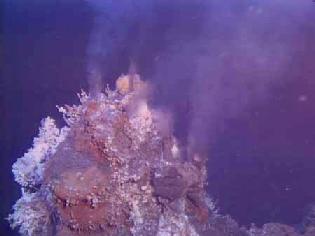 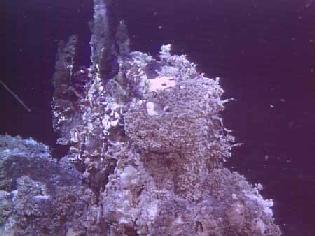 Vents of the ASHES vent field. Top: Hell Vent (fluid at 290oC; bottom: Mushroom Vent with tube worms. |
July 11, 1999
Science Report - Saturday, July 11
Ships Location: 45 56.0/130 00.8
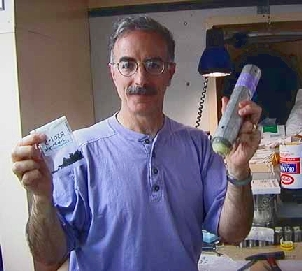
"Chapstick corers" invented for dive 501 to collect volcanic glass chips. |
July 10, 1999
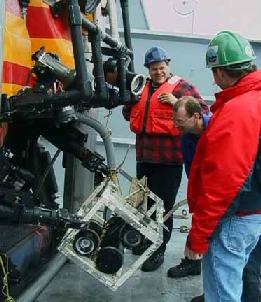 Time-lapse camera deployed at Marker 33 for one year in 1998 and 1999, documenting the colonization of animals at the eruption site. |
Ships Location: 45 55.2/129 59.6
After ROPOS dive 500 came up this morning, we recovered the navigation transponders that we had put down earlier in the cruise. ROPOS dive 501 then deployed the time lapse camera at Marker 33 where it will stay for another year, and then ROPOS started a series of geologic traverses to better define the extent of the 1998 lava flow just south of the area we mapped last year. We think some of the southern-most vent sites we have found (Marker 113, Joystick vent, and Bag City,) are actually located along the eruptive fissure of a very young, but pre-1998 lava flow. This young lava flow is difficult to distinguish from the 1998 lava, so we will be making careful traverses to map out the transitions from one lava flow to another. This will help us better constrain the volume of the 1998 eruption. Also, knowing the age of the lavas in which each vent is located is critical information for interpreting their chemistry and biology.
July 9, 1999
Science Report - Friday, July 9
Ships Location: 45 56.1/129 58.9
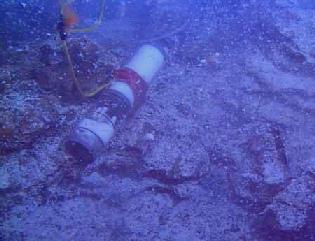 Deployment of the osmosampler at Magnesia Vent. |
July 8, 1999
Science Report - Thursday, July 8
Ships Location: 46 03.8/129 57.7
 CASM vent with lush tubeworms and hydrothermal fluid venting from a chimney. |
 Later in dive
497, ROPOS moved further north along Axials north rift zone to where four
extensometer instruments were deployed last year. (photo left) These instruments
have measured the distance across the rift zone once a day since then
to look for changes related to magma movements under the volcano. ROPOS
had to return to the surface briefly during this operation, but then returned
to finish the job on dive 498. ROPOS found each instrument on the bottom
and moved each one to the elevator mooring,
then released the mooring from its anchor so that it could recovered at
the surface by the ship. We plan to download the data from the instruments,
refurbish them, and then deploy them again for another year deployment.
Later in dive
497, ROPOS moved further north along Axials north rift zone to where four
extensometer instruments were deployed last year. (photo left) These instruments
have measured the distance across the rift zone once a day since then
to look for changes related to magma movements under the volcano. ROPOS
had to return to the surface briefly during this operation, but then returned
to finish the job on dive 498. ROPOS found each instrument on the bottom
and moved each one to the elevator mooring,
then released the mooring from its anchor so that it could recovered at
the surface by the ship. We plan to download the data from the instruments,
refurbish them, and then deploy them again for another year deployment.
July 7, 1999
Science Report - Wednesday, July 7
Ships Location: 46 00.9/130 01.5
ROPOS collected Imagenex data all night as dive 496 continued into the morning when it cut the anchor line holding down the rumbleometer.
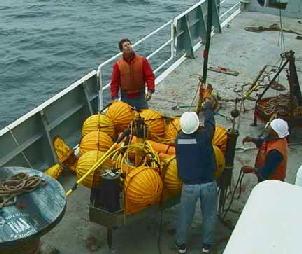 Rumbleometer safely on deck of the Thompson after surviving a lava flow. |
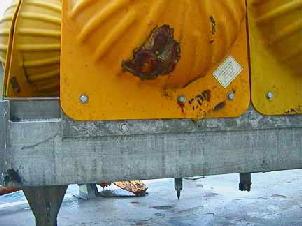 Slight melting of the Rumbleometer's floatation. |
This evening, ROPOS went back in the water for dive 497, this time on Axial's north rift zone to recover and deploy acoustic extensometer instruments with the elevator, and then to visit CASM, a high-temperature vent site at the northern end of the caldera, for biological and slurp sampling and to recover temperature probes deployed there last year.
July 6, 1999
Science Report - Tuesday, July 6
Ships Location: 45 55.9/129 59.0
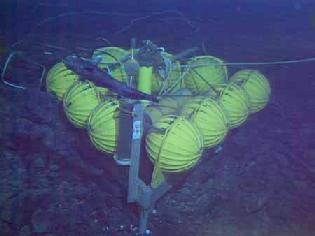 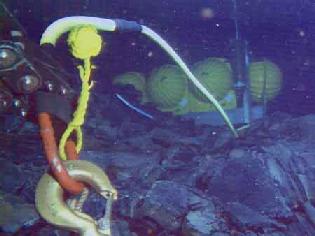 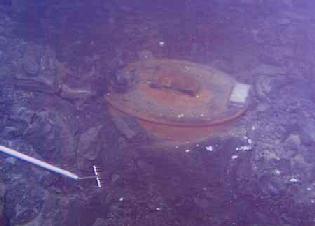  From top to bottom: Rumbleometer stuck in lava flow; then ROPOS attaching lines for recovery attempt; Rumbleometer's anchor remains in lava flow; Instrument floating free for recovery! |
July 5, 1999
Science update:
Not wanting to slight the little guys, in this case microbes, we wanted to highlight one of the other new breakthroughs on this cruise...
Hunting for High Temperature Microbes
Julie Huber  One of the best things
about being a hydrothermal vent microbiologist is hunting for exciting
microbes (photo right) that push the limits of life by surviving at
environmental extremes such as high temperature and pressure. Our
lab at the University of Washington,
headed up by Dr.
John Baross, is always in search of high temperature microorganisms,
referred to as hyperthermophilic archaea. These are the most heat-loving
of all known microorganisms, and all have temperature optima above 80
C. Because the surface of early Earth was likely much hotter than it is
now, many scientists believe that these hyperthermophiles may have
been the earliest life forms on earth. By studying these microbes,
then, we can peer into the past, as well as into the possibility of
life in the subsurface biosphere existing below the seafloor. The
hard part, though, is catching the bugs. It takes a lot of luck to hunt
them down, but a little preparation doesn't hurt either.
One of the best things
about being a hydrothermal vent microbiologist is hunting for exciting
microbes (photo right) that push the limits of life by surviving at
environmental extremes such as high temperature and pressure. Our
lab at the University of Washington,
headed up by Dr.
John Baross, is always in search of high temperature microorganisms,
referred to as hyperthermophilic archaea. These are the most heat-loving
of all known microorganisms, and all have temperature optima above 80
C. Because the surface of early Earth was likely much hotter than it is
now, many scientists believe that these hyperthermophiles may have
been the earliest life forms on earth. By studying these microbes,
then, we can peer into the past, as well as into the possibility of
life in the subsurface biosphere existing below the seafloor. The
hard part, though, is catching the bugs. It takes a lot of luck to hunt
them down, but a little preparation doesn't hurt either.
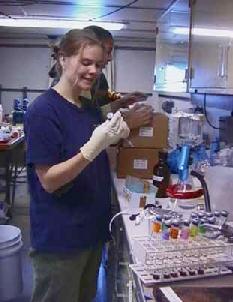 Before going
to sea, I mixed up a wide array of nutritional media to try to mimic the
natural environment of the subsurface seafloor. Because most high temperature
archaea have been found to metabolize sulfur in some way, much of our
media collection includes elemental sulfur, which is formed from geothermal
hydrogen sulfide (see
discussion in today's perspective). Additionally, most of these hyperthermophiles
are obligate anaerobes, meaning they cannot grow in the presence of oxygen.
When a sample comes on deck from the volcanic fluids from Axial, we inject
some of this fluid into our anaerobic test tubes, careful to avoid any
contamination by oxygen or other substances that may prove deadly to these
microbes. We then place our tubes in incubator ovens set at different
temperatures. (photo left) We commonly culture microbes at 55 C (referred
to as thermophiles) and 90 C (hyperthermophiles). Every once in awhile,
though, we try to push the temperature limit by incubating above 100 C.
Currently, the highest known upper temperature limit for growth of a living
organism is 113 C by a sulfur-dependent hyperthermophilic Archaea called
Pyrolobus.
Before going
to sea, I mixed up a wide array of nutritional media to try to mimic the
natural environment of the subsurface seafloor. Because most high temperature
archaea have been found to metabolize sulfur in some way, much of our
media collection includes elemental sulfur, which is formed from geothermal
hydrogen sulfide (see
discussion in today's perspective). Additionally, most of these hyperthermophiles
are obligate anaerobes, meaning they cannot grow in the presence of oxygen.
When a sample comes on deck from the volcanic fluids from Axial, we inject
some of this fluid into our anaerobic test tubes, careful to avoid any
contamination by oxygen or other substances that may prove deadly to these
microbes. We then place our tubes in incubator ovens set at different
temperatures. (photo left) We commonly culture microbes at 55 C (referred
to as thermophiles) and 90 C (hyperthermophiles). Every once in awhile,
though, we try to push the temperature limit by incubating above 100 C.
Currently, the highest known upper temperature limit for growth of a living
organism is 113 C by a sulfur-dependent hyperthermophilic Archaea called
Pyrolobus.
Two weeks ago, we got very lucky in our little ship-bound lab and managed to find a positive culture tube happily growing above 100 C. This microbe, growing anaerobically with elemental sulfur, was isolated from ~70 C fluid at Marker 33, a well-studied site on the new lava flow here at Axial. The fact that we have found a microbe (or group of microbes) growing at such a high temperature, yet isolated from fluids much below its temperature of growth, strongly suggests that there is a hotter subsurface environment that these microorganisms are growing and thriving in, perhaps hundreds of meters below the seafloor. It is not until a perturbation to the system occurs that these fluids make it to the seafloor, though, so the recent eruption here at Axial makes it an ideal study site for collecting these fluids and searching for subsurface microorganisms. By studying this exciting microbe, we hope to learn more about the metabolic wonders of life at high temperature and what limits life. Additionally, we will gain important clues about the deep subsurface and early environments here on earth, perhaps allowing us to speculate beyond our own planet to the possibility of life on other planets and moons. The hunt continues...
July 4, 1999
Science Report - Sunday, July 4
Ships Location: 45 55.9/129 58.8
 New lava flow at the bottom of the fissure, southern extent of 1998 eruption. (Dive 494) |
July 3, 1999
Science update...
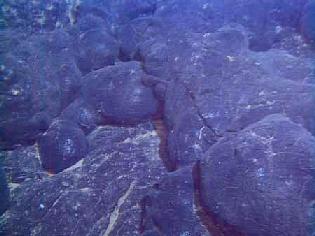
Dive 493 in progress at southern extent of 1998 lava flow. Photo shows new lava flowing onto the old lava (old lava in lower left corner). |
Note: Scientists are very busy during this Dive and can not send a full
report at this time. Evidently they have made some very exciting
discoveries which they will report on in the next few days.
NeMO Webmaster
July 2, 1999
Chief Scientist's Weekly Report
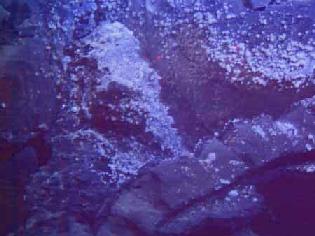 Gelatinous masses (bag creatures) at a new vent (Bag City) discovered by ROPOS dive 491. |
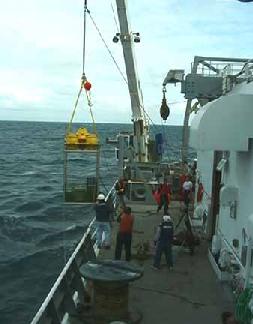 For
several days, we have been waiting for the weather to calm down enough
to retrieve the elevator (photo left). Several postponements arose from
the concern that the wave surge would dislodge some of the samples and/or
instruments and they would be washed out of the elevator at the surface.
During the late afternoon, the command was sent from the surface to release
the elevator from the seafloor with its cargo of instruments and samples.
The personnel of the T. G. Thompson did
a magnificent job in recovering the package in a combined small boat and
ship recovery in less than optimal conditions.
For
several days, we have been waiting for the weather to calm down enough
to retrieve the elevator (photo left). Several postponements arose from
the concern that the wave surge would dislodge some of the samples and/or
instruments and they would be washed out of the elevator at the surface.
During the late afternoon, the command was sent from the surface to release
the elevator from the seafloor with its cargo of instruments and samples.
The personnel of the T. G. Thompson did
a magnificent job in recovering the package in a combined small boat and
ship recovery in less than optimal conditions.
We have made much progress in the past week on NeMO99 with several long and very successful dives. Most of the instruments deployed last year have been recovered and many of the key samples for the various disciplines have been successfully recovered. The hydrothermal system that arose from the 1998 dike injection and eruption is still vigorous, and it appears that we will be able to continue productive studies of its chemical and biological processes well into the future.
July 1, 1999
Science Report - Thursday, July 1
Ships Location: 45 54.2/129 55.2
We set a new record for ROPOS bottom time during dive 491 (38 hours)!
Highlights of dive 491 included lots of samples with the slurp
sampler, recovering instruments into
the elevator, recovering bacterial
traps deployed last summer, biological
samples at a number of vent sites, and scanning sonar mapping. One
interesting development during the dive was 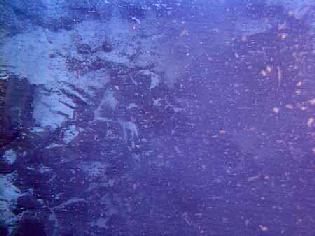 the realization that a vent site that we visited on dive 488 and had thought
was new (located near the northern end of the 1998 lava flow near
Milky vent), was actually Magnesia vent (photo right), which we had
sampled last year. The reason we had thought it was new was partly because
one navigation transponder was not working properly on dive 488 and our
positions were offset, and also because the vent now looks very different
from how it appeared last year. Last summer, Magnesia vent had milky-looking
fluid venting with very fine white particles entrained in the fluid. This
year, large white floc particles are coming out of the vent (like at other
"snowblower" vents), but so much floc is coming out and settling to the
bottom that the surrounding area looks like a snowy
winter scene. A big change from last year.
the realization that a vent site that we visited on dive 488 and had thought
was new (located near the northern end of the 1998 lava flow near
Milky vent), was actually Magnesia vent (photo right), which we had
sampled last year. The reason we had thought it was new was partly because
one navigation transponder was not working properly on dive 488 and our
positions were offset, and also because the vent now looks very different
from how it appeared last year. Last summer, Magnesia vent had milky-looking
fluid venting with very fine white particles entrained in the fluid. This
year, large white floc particles are coming out of the vent (like at other
"snowblower" vents), but so much floc is coming out and settling to the
bottom that the surrounding area looks like a snowy
winter scene. A big change from last year.
ROPOS came back on deck this morning and we had hoped to recover the elevator mooring and be back in the water this afternoon, but the wind and seas have been building since yesterday and have caused the elevator recovery and the dive to be postponed. More rock cores from the south rift zone will be collected, and the samples and data collected during dive 491 will be processed in the meantime.
June 30, 1999
Science Report - Wednesday, June 30
Ships Location: 45 56.3/129 59.1
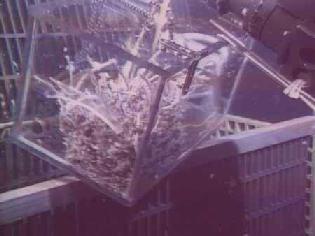 Biobox being transferred to the elevator to bring the samples up to the ship. (Dive 491, 1999) |
June 29, 1999
Science Report - Tuesday, June 29
Ships Location: 45 55.9/129 58.9
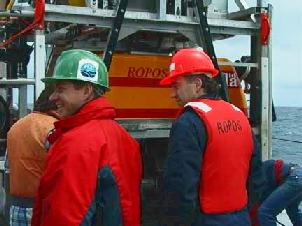 Keith Sheperd and Craig Elder working on ROPOS before dive 491. |
June 28, 1999
Science Report - Monday, June 28
Ships Location: 45 51.1/129 54.1
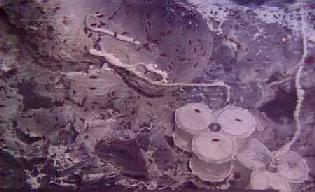
Photo from dive 488 of Cloud Vent area. Pictured are bacterial traps amongst a new species of scale worms. |
June 27, 1999
Chief Scientist's Weekly Report 6-27
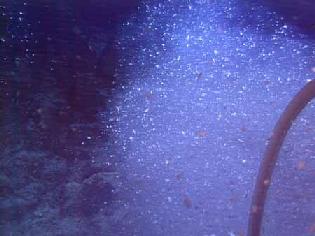 This has been
a great day out here at Axial Volcano. Were just now recovering the ROPOS
after working 19 hours on the bottom. During this dive, we were
able to accomplish much of the sampling we have strived to do over the
last few days. Between the new and improved Vent
Fluid Sampler and the Suction
sampler, more than 30 vent fluid and biological samples were taken
at several locations. These samples will provide critical material for
analysis for most of the investigators on board and is probably a record
for samples taken during a single dive. We also learned a lot about the
"state" of the system. Most of the venting is now concentrated around
the Marker 33 and Cloud Vent (photo above)
sites, which may have elevated heat fluxes relative to last year. In fact,
we only found one significant vent at the northern end of the system,
although it was a very interesting one. This vent, which was in the vicinity
of a series of vents characterized by their milky color last year ( Milky,
Magnesia etc.), was now emitting a steady cloud of large white flocs
(photo right and calendar photo of the day) which covered the surrounding
rocks with a blanket of "snow" and brought to mind one of those "Christmas
scenes in a glass" after theyve been shaken up. What we are probably
witnessing at this site is the late stage of a subsurface microbial community
that is producing large quantities of sulfurous material which they make
from metabolizing the dissolved hydrogen sulfide in the fluids. This material
is produced in sufficient quantity and rapidly enough to produce a steady
stream of this material. This probably requires a special balance of a
high hydrogen sulfide concentration, availability of subsurface cavities,
and a relatively slow amount of flow into the cavity.
This has been
a great day out here at Axial Volcano. Were just now recovering the ROPOS
after working 19 hours on the bottom. During this dive, we were
able to accomplish much of the sampling we have strived to do over the
last few days. Between the new and improved Vent
Fluid Sampler and the Suction
sampler, more than 30 vent fluid and biological samples were taken
at several locations. These samples will provide critical material for
analysis for most of the investigators on board and is probably a record
for samples taken during a single dive. We also learned a lot about the
"state" of the system. Most of the venting is now concentrated around
the Marker 33 and Cloud Vent (photo above)
sites, which may have elevated heat fluxes relative to last year. In fact,
we only found one significant vent at the northern end of the system,
although it was a very interesting one. This vent, which was in the vicinity
of a series of vents characterized by their milky color last year ( Milky,
Magnesia etc.), was now emitting a steady cloud of large white flocs
(photo right and calendar photo of the day) which covered the surrounding
rocks with a blanket of "snow" and brought to mind one of those "Christmas
scenes in a glass" after theyve been shaken up. What we are probably
witnessing at this site is the late stage of a subsurface microbial community
that is producing large quantities of sulfurous material which they make
from metabolizing the dissolved hydrogen sulfide in the fluids. This material
is produced in sufficient quantity and rapidly enough to produce a steady
stream of this material. This probably requires a special balance of a
high hydrogen sulfide concentration, availability of subsurface cavities,
and a relatively slow amount of flow into the cavity.
We were heading back to the Marker 33 site to recover the rest of the instruments (into the elevator) when the ROPOS team determined that the vehicle had to return to the surface for maintenance. It certainly served the scientists well today.
News from the microbiology lab on board was very intriguing and potentially very exciting. Some of the cultures made from samples taken at Marker 33 continued to grow at temperatures in excess of 90 Centigrade, which is very unusual. We await further word on this from microbiologists Julie Huber and Sheryl Bolton.
We hope to begin a very ambitious dive early in the morning that will likely last through most of the day.
June 26, 1999
Science Report - Saturday, June 26
Ships Location: 45 55.9/129 59.0
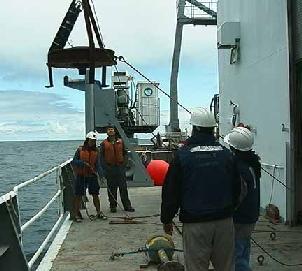 Deployment of the range meter for calibrating the transponders used for ROV navigation underwater. |
June 25, 1999
Science Report - Friday, June 25
Ships Location: 45 56.0/-129 58.9
 Dave Butterfield and Julie Huber retrieving samples from the fluid sampler after Dive 485. |
Frustration is an inevitable part of Oceanography, because any time you put something over the side of a ship at sea, it may not work or you might never get it back. This is particularly true when you have something designed to work at the bottom of the ocean - perhaps the most challenging engineering environment on Earth due to the corrosive conditions and the
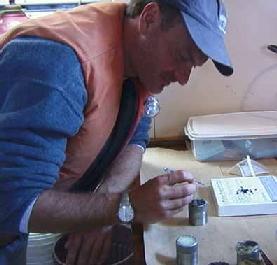
John Chadwick extracting rock chips from the wax cups at the bottom of the rock corer. |
June 24, 1999
Science Report - Thursday, June 24
Ships Location: 45 45.2/-130 08.3
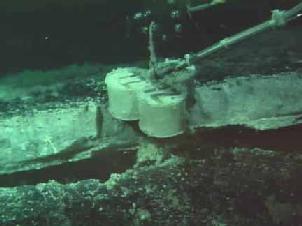 ROPOS returned to the Marker 33 area early today for dive 484. Bacterial
traps (right) that were left at the vent site since last summer were recovered
and new traps put in place for the next year. The bacteria that have colonized
these traps will have their DNA analyzed to find out what organisms are
living in these seafloor hot springs. An extensive biosphere of primitive
microorganisms is believed to live in high temperature environments below
the seafloor (at temperatures even above the boiling point of water at
sea level!). This deep hot biosphere is brought to the surface and made
accessible to sampling by submarine volcanic eruptions. This is a lot
of what motivates the research in the NeMO Program
- the interactions between volcanism, hydrothermal chemistry, and biology.
ROPOS returned to the Marker 33 area early today for dive 484. Bacterial
traps (right) that were left at the vent site since last summer were recovered
and new traps put in place for the next year. The bacteria that have colonized
these traps will have their DNA analyzed to find out what organisms are
living in these seafloor hot springs. An extensive biosphere of primitive
microorganisms is believed to live in high temperature environments below
the seafloor (at temperatures even above the boiling point of water at
sea level!). This deep hot biosphere is brought to the surface and made
accessible to sampling by submarine volcanic eruptions. This is a lot
of what motivates the research in the NeMO Program
- the interactions between volcanism, hydrothermal chemistry, and biology.
ROPOS also visited Cloud
vent for the first time this trip and found that it was also still
vigorously venting and had been much more extensively colonized by vent
animals than we saw last summer (including scale worms, tubeworms, and
the new species of scale worm discovered last year).  In fact, there were so many scale worms (left) around Cloud vent that
it looked like the lava rocks had chickenpox! At the end of the dive
the time-lapse camera that had been at Marker 33 for a year was recovered,
and all signs suggest that it worked (though the film will not be developed
until after the cruise). Our visits to Marker 33 and Cloud vent are very
encouraging because they show that the venting in the 1998 lava flow
has not diminished significantly, and yet many changes have taken place
since last year. The story that is unfolding is an interesting one,
but we are only at the beginning - there should be many more details to
come.
In fact, there were so many scale worms (left) around Cloud vent that
it looked like the lava rocks had chickenpox! At the end of the dive
the time-lapse camera that had been at Marker 33 for a year was recovered,
and all signs suggest that it worked (though the film will not be developed
until after the cruise). Our visits to Marker 33 and Cloud vent are very
encouraging because they show that the venting in the 1998 lava flow
has not diminished significantly, and yet many changes have taken place
since last year. The story that is unfolding is an interesting one,
but we are only at the beginning - there should be many more details to
come.
June 23, 1999
Science Report - Wednesday, June 23
Ships Location: 45 41.2/-130 04.4
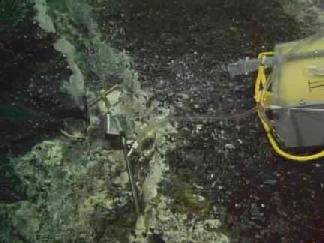 ROPOS
made its first visit to the bottom early this morning
(dive 483). We dove on the most vigorous vent site that we had found last
year (Marker 33) where we had deployed instruments, samplers, and a time-lapse
camera. What we found was that the site is still venting strongly,
and had been colonized by new animals since last summer.
In fact, a clump of tubeworms were right in front of the time-lapse camera,
which took a photo every 30 hours over the last year, so it should have
recorded their colonization and growth. ROPOS also recovered an OSMO
sampler (photo left), a temperature recorder, and several bacteria
traps that had been at the vent since last summer, but the recovery
of the time-lapse camera will wait until the next dive. We also took several
samples at the vent with the suction
sampler for chemical and biological studies. The next dive will go
back to Marker 33 to recover and redeploy more experiments there before
exploring more sites on the 1998 lava flow.
ROPOS
made its first visit to the bottom early this morning
(dive 483). We dove on the most vigorous vent site that we had found last
year (Marker 33) where we had deployed instruments, samplers, and a time-lapse
camera. What we found was that the site is still venting strongly,
and had been colonized by new animals since last summer.
In fact, a clump of tubeworms were right in front of the time-lapse camera,
which took a photo every 30 hours over the last year, so it should have
recorded their colonization and growth. ROPOS also recovered an OSMO
sampler (photo left), a temperature recorder, and several bacteria
traps that had been at the vent since last summer, but the recovery
of the time-lapse camera will wait until the next dive. We also took several
samples at the vent with the suction
sampler for chemical and biological studies. The next dive will go
back to Marker 33 to recover and redeploy more experiments there before
exploring more sites on the 1998 lava flow.
June 22, 1999
Science Report - Tuesday, June 22
Ships Location: 45 56.0/-129 58.7
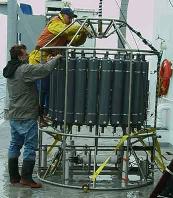 The Thompson
is now on station over the 1998
lava flow at Axial Volcano. We arrived here yesterday evening, and
the first task was to turn on the navigation
transponders that we left behind here last summer. Since then, ROPOS
has gotten wet twice, but we havent seen the bottom yet. This is because
of complications related to removing air from ROPOSs hydraulic system,
and communication problems with the fluid sampler. Neither of these are
serious and will be worked out soon. This is fairly typical for an oceanographic
research cruise. The ROPOS system is very complex and it often takes a
day or two to work out problems before things get going smoothly. Basically,
if anything is going to go wrong, it usually happens in the first few
days. In the meantime, we have completed one
CTD cast (above photo)
The Thompson
is now on station over the 1998
lava flow at Axial Volcano. We arrived here yesterday evening, and
the first task was to turn on the navigation
transponders that we left behind here last summer. Since then, ROPOS
has gotten wet twice, but we havent seen the bottom yet. This is because
of complications related to removing air from ROPOSs hydraulic system,
and communication problems with the fluid sampler. Neither of these are
serious and will be worked out soon. This is fairly typical for an oceanographic
research cruise. The ROPOS system is very complex and it often takes a
day or two to work out problems before things get going smoothly. Basically,
if anything is going to go wrong, it usually happens in the first few
days. In the meantime, we have completed one
CTD cast (above photo) 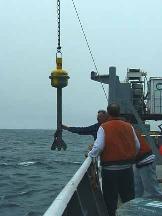 (to get background water samples) and four rock cores (photo right) (to
collect basalt samples on Axials south rift zone). We were also visited
by a group of Dalls porpoises (calendar photo) today. Right now ROPOS
is being prepared for another dive, that will concentrate on recovering
many of the instruments and samplers that have been deployed since last
year. The science party is anxious to see how the 1998 lava flow may have
changed. Will the vents we saw last year still be active? If so,
will their chemistry have changed? Will the animals communities be different
at the vents? Stay tuned!
(to get background water samples) and four rock cores (photo right) (to
collect basalt samples on Axials south rift zone). We were also visited
by a group of Dalls porpoises (calendar photo) today. Right now ROPOS
is being prepared for another dive, that will concentrate on recovering
many of the instruments and samplers that have been deployed since last
year. The science party is anxious to see how the 1998 lava flow may have
changed. Will the vents we saw last year still be active? If so,
will their chemistry have changed? Will the animals communities be different
at the vents? Stay tuned!
June 21, 1999
Not available.June 20, 1999
Not available.R/V Wecoma Science Report:
June 25, 1999
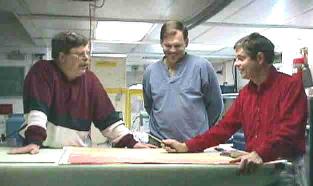 Chief Scientist Dr.
Ed Baker (right) reviews the distribution of operations over Axial
Volcano with Drs. Dick
Feely (left) and Joe
Resing (center) in one of the Wecoma's labs. So far at Axial the Vents
team has conducted eight "tow-yo"
operations and 16 vertical
CTD casts. These operations define the dispersal of hydrothermal plumes
away from Axial Volcano, allowing the scientists to estimate the rate
at which hydrothermal fluids are flowing from cracks in the floor of the
caldera.
Chief Scientist Dr.
Ed Baker (right) reviews the distribution of operations over Axial
Volcano with Drs. Dick
Feely (left) and Joe
Resing (center) in one of the Wecoma's labs. So far at Axial the Vents
team has conducted eight "tow-yo"
operations and 16 vertical
CTD casts. These operations define the dispersal of hydrothermal plumes
away from Axial Volcano, allowing the scientists to estimate the rate
at which hydrothermal fluids are flowing from cracks in the floor of the
caldera.
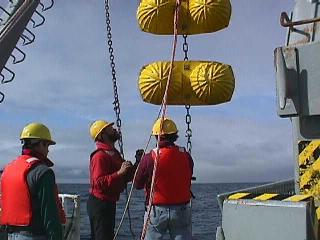 Vents scientists launch a CTD from the fantail of the Wecoma. The 1200
pound instrument and sampling package is lifted off the deck with the
Wecoma's winch, then carried out beyond the ship's stern with the moveable
A-frame overhead. The package is lowered some 1500 m (about 4500 ft) to
within a few meters of the seafloor, continuously sampling the temperature,
salinity, and optical turbidity of the water column. On the way back up,
the plastic sample bottles are closed to return water samples to the scientists
for detailed analysis.
Vents scientists launch a CTD from the fantail of the Wecoma. The 1200
pound instrument and sampling package is lifted off the deck with the
Wecoma's winch, then carried out beyond the ship's stern with the moveable
A-frame overhead. The package is lowered some 1500 m (about 4500 ft) to
within a few meters of the seafloor, continuously sampling the temperature,
salinity, and optical turbidity of the water column. On the way back up,
the plastic sample bottles are closed to return water samples to the scientists
for detailed analysis.
June 24, 1999
After a week of solid work here at Axial we have a good idea of the sources and fate of the hydrothermal venting initiated by the 1998 eruption. As in the summer of 1998, the principal venting source remains the new lava field, with a minor contribution from the long-lasting ASHES site. Both the optical and temperature intensity of the plume are comparable to that found last year, indicating little decline in the hydrothermal activity. The horizontal extent of the plume is also similar to 1998. Thus the NeMO site appears headed for a long period of substantial discharge. This trend is in sharp contrast to the previous two eruptions, at CoAxial and Gorda Ridge, both of which experienced a significant decline after 18 months.
Our plume mapping and sampling has defined a narrow and intense plume being advected primarily to the southwest, out of the open end of the caldera. The plume bends around the caldera and streams to the west, with the core only a few km wide. We suspect that the currents are being steered by the bathymetry. The current records for last year that we recovered on this cruise will let us test that hypothesis, and should provide a basis for a good estimate of the heat and chemical flux from the new eruption site.
In addition to the plume work, we have successfully recovered all 9 moorings from last year, and deployed 6 new ones in their place. The Thomas Thompson will deploy our other 3 moorings after their work with ROPOS is completed. New this year on the moorings are 14 optical-temperature sensors--"mini MAPRs" that will monitor the plume more clearly than can temperature alone. Also new on the moorings are 2 "osmosamplers" built by researchers from MBARI. They will continuously sample plume waters into very small diameter tubes, which will be analyzed after recovery next year.

(image shows cumulation of plume studies at Cleft from 1986-97)
We have about 2 more day's work here, after which we will proceed
south to the
Cleft segment for 3 days to continue our 15 yr time series at
those venting sites. Everyone on board has been working very long hours
and accomplishing more than they anticipated.
That's the news from Wecoma. We'll arrive in Newport the morning of the 29th. Cheers, Ed Baker
June 23, 1999
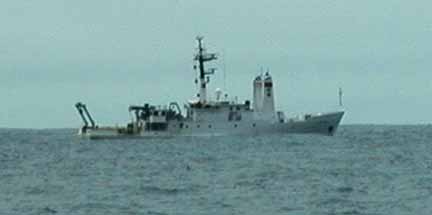
Photo of Wecoma taken from R/V Thompson on 6/22/99 at Axial Volcano site.
 Mooring recovery/deployments. One of the keystones
of NeMO is continuous monitoring of hydrothermal activity at Axial
Volcano. An integral part of that effort are underwater moorings--strings
of instruments anchored to the seafloor and supported by glass floats.
Here scientists onboard the Wecoma are busy adding a set of floats to
a mooring being deployed within the caldera of Axial Volcano. Instruments
on the mooring include current meters to record the direction and speed
of the water that disperses the hydrothermal plume, temperature and optical
sensors to monitor the intensity of the plume, and a special instrument
that continuously samples a tiny volume of plume water for later chemical
analysis. Wecoma has already retrieved 9
moorings deployed in 1998, 6 months after the eruption, and is deploying
9 more moorings that will monitor plume conditions until the summer of
2000.
Mooring recovery/deployments. One of the keystones
of NeMO is continuous monitoring of hydrothermal activity at Axial
Volcano. An integral part of that effort are underwater moorings--strings
of instruments anchored to the seafloor and supported by glass floats.
Here scientists onboard the Wecoma are busy adding a set of floats to
a mooring being deployed within the caldera of Axial Volcano. Instruments
on the mooring include current meters to record the direction and speed
of the water that disperses the hydrothermal plume, temperature and optical
sensors to monitor the intensity of the plume, and a special instrument
that continuously samples a tiny volume of plume water for later chemical
analysis. Wecoma has already retrieved 9
moorings deployed in 1998, 6 months after the eruption, and is deploying
9 more moorings that will monitor plume conditions until the summer of
2000.
June 22, 1999
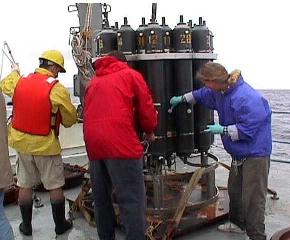 The principal activity of the Wecoma cruise is to map and sample the hydrothermal
plume formed when hot fluids issuing from the crust mix with ambient seawater.
This work provides information on the chemical composition of the hydrothermal
fluids. In combination with the mooring work, it will also allow us to make
estimates of the total rate at which heat and chemicals are supplied to
the ocean around Axial from the eruption. Here scientists sample seawater
collected in plastic sampling bottles almost a mile below the sea surface.
Inside the ring of sampling bottles is a CTD--conductivity, temperature,
and depth--instrument that senses the temperature and optical intensity
of the hydrothermal plume. When plume water is encountered, a scientists
sends a signal to the CTD to close a bottle and capture a water sample.
The principal activity of the Wecoma cruise is to map and sample the hydrothermal
plume formed when hot fluids issuing from the crust mix with ambient seawater.
This work provides information on the chemical composition of the hydrothermal
fluids. In combination with the mooring work, it will also allow us to make
estimates of the total rate at which heat and chemicals are supplied to
the ocean around Axial from the eruption. Here scientists sample seawater
collected in plastic sampling bottles almost a mile below the sea surface.
Inside the ring of sampling bottles is a CTD--conductivity, temperature,
and depth--instrument that senses the temperature and optical intensity
of the hydrothermal plume. When plume water is encountered, a scientists
sends a signal to the CTD to close a bottle and capture a water sample.
June 21, 1999
Not available, see Wecoma teacher's log.
June 20, 1999
Not available, see Wecoma teacher's log.
June 19, 1999
This morning (Sat) we are CTD towing the east wall of the caldera and will be working in this area for a few days, trying to get as much done as possible before the Thomas Thompson arrives.
June 18, 1999
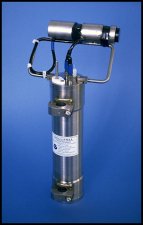 Friday was devoted to mooring recovery, collecting all 9 moorings in about
12 hrs--quite a busy day! All equipment was recovered successfully. Moorings
at Sonne
showed heavy corrosion and Fe encrustation. One of the screws holding
the LSS bracket to a MAPR
pressure case was corroded to the size of a pin.
Friday was devoted to mooring recovery, collecting all 9 moorings in about
12 hrs--quite a busy day! All equipment was recovered successfully. Moorings
at Sonne
showed heavy corrosion and Fe encrustation. One of the screws holding
the LSS bracket to a MAPR
pressure case was corroded to the size of a pin.
June 17, 1999
Weather has been uncommonly good, with little wind and sea, so we've accomplished
a lot. Wecoma
arrived Thursday evening and made two CTD
casts over the new
lava flow. Hydrothermal activity is still plentiful, 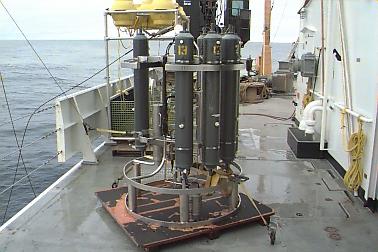 with optical anomalies comparable to last year. Visual inspection of the
filters suggests most of the particles are sulfur/biogenic, not metal
sulfides. Several people have said they can smell sulfur impregnated in
the mooring lines we've collected. Height of the maximum plume horizon
seems to be 50-100 m less than last year, suggesting a diminishment in
the heat flux.
with optical anomalies comparable to last year. Visual inspection of the
filters suggests most of the particles are sulfur/biogenic, not metal
sulfides. Several people have said they can smell sulfur impregnated in
the mooring lines we've collected. Height of the maximum plume horizon
seems to be 50-100 m less than last year, suggesting a diminishment in
the heat flux.
For more information:
Credits/Contacts
oar.pmel.vents.webmaster@noaa.gov